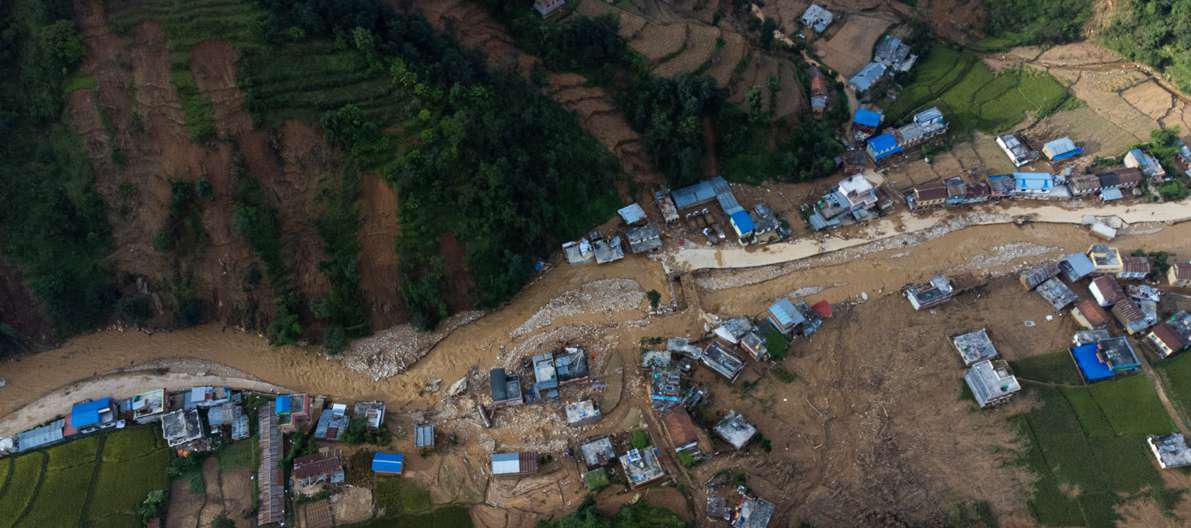Disaster | Loss and Damage | Infrastructure damages | Economic loss

The devastating floods and landslides triggered by heavy rainfall in late September (26 to 28 September) have caused an estimated Rs 46.68 billion in damages to Nepal’s economy, according to a preliminary assessment by the National Disaster Risk Reduction and Management Authority (NDRRMA).
The assessment highlights extensive damage across physical infrastructure, accounting for 83.4% (Rs 38.92 billion) of the total estimated loss.
Nepal witnessed unprecedented rainfall on 26 to 28 September triggering floods, landslides (mudslides), and flash floods across different parts of the country — leading to the death of 249 individuals including 60 children. 177 were injured while 18 are still missing.
Kathmandu experienced record-breaking rainfall on Friday (27th) and Saturday (28th), with the Department of Hydrology and Meteorology (DHM) reporting the highest rainfall ever recorded in the valley since 2002. On Saturday, 239.7 millimeters of rain fell at Tribhuvan International Airport, surpassing the previous record of 177 millimeters set in 2002.
The heavy rainfall-induced disasters damaged 41 roads and highways, with an estimated cost of Rs 27.98 billion for repairing and maintaining the damaged infrastructure. Hydropower plants also sustained significant damage with 26 hydropower facilities damaged, resulting in an estimated loss of Rs 3.18 billion [see table below].
Table 1: Breakdown of physical infrastructure losses
| Infrastructure type | Units | Amount (In NRs billion) |
| Roads and Highways | 41 | 27.98 |
| Water Supply and Sanitation | 168 | 5.91 |
| Hydropower | 26 | 3.02 |
| Bridges | 44 | 1.04 |
| Telecommunications | 446 | 0.15 |
| Public transportation | 84 | 0.73 |
| Public buildings | - | 0.1 |
The productive sector, particularly agriculture and livestock, also faced significant losses leading to an estimated economic loss of Rs 5.88 billion. In total, 65,380 hectares of agricultural land and 26,698 livestock have been affected.
Table 2: Key breakdown of agriculture losses
| Agriculture category | Districts | Hectare/ Livestock | Total estimated loss (In Rs million) |
| Paddy | Saptari, Siraha, Dhanusha, Mahottari, Sarlahi, Rautahat, Bara, Parsa, Nawalpur, Baglung, Khotang, Jhapa, Kailali, Lamjung, Parbat, Kaski, Syangja, Sindhuli, Makwanpur, Kavre | 65,380 | 3500 |
| Alaichi | Khotang | 1300 | 700 |
| Sugarcane | Parsa | 85 | 340 |
| Fishery | Dhanusha, Mahottari, Sarlahi, Rautahat, and Bara | 458 | 1130 |
| Maize, paddy, and vegetable farm | Kavre (Dhulikhel Municipality) | 296 | 52.8 |
| Livestock | Paanchthar, Ilam, Sunsari, Dhankuta, Solukhumbu, Okhaldhunga, Ramechhap, Dolakha, Lalitpur, All districts of Madhesh Province, Kavre (Dhulikhel Municipality) | 26,698 | - |
Similarly, the estimated loss and damage across irrigation projects amounts to Rs 1.35 billion.
Table 3: Breakdown of losses in the irrigation project
| Irrigation project | Estimated loss (In Rs million) |
| Mahakali Irrigation Project in Kanchanpur | 1140 |
| Bagmati Irrigation Project eastern and western canals | 54 |
| 10 branch canals under the Sunsari-Morang Irrigation Project | 50 |
| Kamala Irrigation Management Project | 50 |
| Jhajh Irrigation Canal Project | 30 |
| Koshi Pump-Chandra Canal Project | 5 |
| Narayani Irrigation Management Project | 1 |
The social sector has been severely impacted, particularly in housing and settlements.
The report indicates that 5,996 homes were completely destroyed, while 13,049 were damaged, displacing 10,807 families and affecting 16,243 individuals who are now living in public shelters.
Six health facilities were completely destroyed and 43 were partially damaged in the health sector. Similarly, in the education sector, six schools were completely destroyed and 136 partially damaged.
Bagmati province recorded the highest number of incidents at 161 which killed 208 people followed by Koshi with 121 incidents and 20 deaths. The highest number of fatalities have been reported in Kavre (79) followed by Lalitpur (46) and Dhading (39) districts.
The report claims that rescue efforts were substantial, with over 17,000 individuals rescued and over 14,800 police personnel deployed across affected areas.
However, Koshi Province recorded the largest financial losses at Rs 434.73 million, followed by Gandaki with Rs 15.36 million and Bagmati at Rs 40.62 million, while other provinces reported comparatively lower figures. The total estimated financial loss across the provinces was Rs 458.07 million.
Read More Stories
Kathmandu’s decay: From glorious past to ominous future
Kathmandu: The legend and the legacy Legend about Kathmandus evolution holds that the...
Kathmandu - A crumbling valley!
Valleys and cities should be young, vibrant, inspiring and full of hopes with...
Israel attacks Iran’s nuclear and military sites, Iran retaliates with drones
In a latest escalation in West Asia, Israel targeted nuclear and missile facilities...